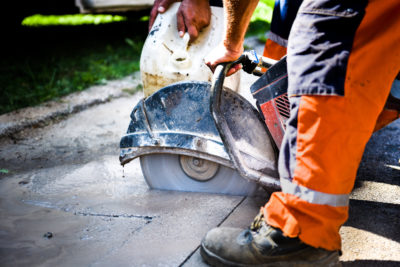Cutting broach holes into different steel structures requires a reliable and heavy-duty power tool. A portable, light-weight but heavy-duty drill that is commonly found on a variety of jobs sites is a magnetic drill. With superior accuracy and efficiency, it’s not surprising that a mag drill is the perfect power tool for steel drilling.
Here is everything you need to know about magnetic drills, how to cut broach holes into steel, and tips on drilling into structures with steel reinforcement.
What are magnetic drills?
A magnetic drill, also known as a mag drill, is a specialised portable power tool used for broaching, tapping, countersinking, and drilling aluminium, carbon steel and other similar materials.
A magnetic drill is beneficial for use on-site where a large steel structure, such as a pipe, is too heavy to move. One of the many great features of a mag drill is it can be positioned in a variety of ways for accurate results no matter the situation: horizontally, vertically and even upside down.
Most magnetic drills come with a control panel that includes:
- A safety switch/indicator light
- Motor on/off switch
- Magnet on/off switch
- An electromagnetic base that magnetises the drill to the steel structure
- A lift detector switch
Other Magnetic drill parts include:
- Motor
- Arbor
- Front support bracket
- Annular cutter
- Feed handles
Magnetic drill Accessories:
- Machine Arbors
- Hole enlarging pilots
- Chuck Arbors
- Sharpening Machine
- Lubrication
What are magnetic drills used for?
Magnetic drills use an annular cutter for cutting broach holes which provide superior accuracy, efficiency and quality on a variety of different job sites.
A heavy-duty mag drill is capable of broaching holes up to 140mm diameter in 100mm + thick steel.
- Building & Construction
- Bridge Rebuilding
- Mining
- Ship Building
- Truck, RV & Special Vehicle Building
- Pipeline, Offshore & Oil Fields
- Welding Shops
- Power Utilities
- Railroad Industries
- Maintenance Facilities
- Mobile Repair Shops
- Machinery Riggers
The process of cutting broach holes through steel
1. Place your magnetic drill on your steel structure.
The electromagnetic base will magnetise the drill in place. Make sure the bottom of the magnet is free from debris otherwise it may lift off the structure during drilling. Magnetic strength is dependent on the thickness of the steel, so the thicker the steel, the stronger the magnetic strength. If your steel structure is too thin, you may clamp another piece of steel below the base of your mag drill.
2. Connect the Annular cutter to your mag drill
Which annular cutter you choose will depend on the diameter of the hole, the depth of the cut and the type of material you are drilling into.
3. Attach the Pilot
A pilot is necessary when using an annular cutter. It will help locate the centre of the hole and will retract up into the mag drill arbour as the hole is made.
4. Attach adjustable safety guard
5. Lubricate
Always use some type of lubrication when working with an annular cutter. Lubrication will help provide a high-quality finish to your broach hole, keeping your magnetic drill cooler and in better condition for long-term use.
6. Turn on the motor and start turning the feed handles with two hands
Start the cut with very gentle pressure, do not force the drill into the hole, this will cause damage to your magnetic drill.
An important tip for drilling into steel reinforced and non-reinforced concrete slabs
Drilling through concrete slabs with steel reinforcement is a more lengthy and difficult process than drilling through concrete without reinforcement and will require thorough concrete scanning before drilling can commence.
So it is important to first determine the type of concrete structure you will be drilling into before choosing the specific type of drill that will best complete the job efficiently and accurately.
For the most effective concrete slab reinforcement and non-reinforcement drilling with minimal vibrations and strain choose a Diamond Core drill.
This is a revolutionary method that enables more accurate and efficient core drilling without causing any damage or vibrations throughout the surrounding area. The main difference between conventional magnetic drills and diamond core drills is that the drill bit consists of a steel tube saturated in diamond beads on the drilling end. With improved accuracy, reduced mess, noise, vibrations and dust, a diamond core drill is the perfect tool for steel reinforcement and non-reinforcement concrete structures where precise circular cuts are required.
The process of drilling with a diamond drill is impressive. The drill works seamlessly by allowing a solid cylinder of concrete to move up through the diamond drill bit to be removed from the hole.
The diamond drill bit is slowly rotated with gentle pressure while it is lubricated with water, or specialised cooling liquids, to prevent overheating.
The core drilling method is just as effective for drilling through concrete without steel reinforcement as it is with drilling through concrete reinforcement.
Magnetic drills and Diamond core drills offer effective solutions for drilling and concrete slab reinforcement drilling. For the best results ensure you are using drills that are kept in great condition with proper cleaning, repairs and maintenance.
Core drilling Perth experts use specialised skills and knowledge to deliver drilling solutions to any job site using only high-quality drills.
Diamond Cut Concrete are trusted core drilling Perth experts with years of experience providing high-quality and efficient drilling solutions. Contact us today for a quote.



